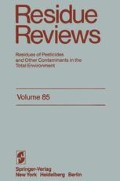Abstract
Two important questions motivating much of the research work in pesticide environmental behavior are: (1) What is the expected environmental concentration-time profile for a pesticide at specific locations in various media during the manufacture, application, and dissipation of the product? (2) What are the hazards to man and his environment resulting from these environmental concentrations?
Access this chapter
Tax calculation will be finalised at checkout
Purchases are for personal use only
Preview
Unable to display preview. Download preview PDF.
References
Blau, G. E., and W. B. Neely: Ecokinetics: A study of the fate and distribution of chemicals in laboratory ecosystems. AIChE J. 21, 854 (1975).
Cairns, J. Jr., K. L. Dickson, and A. W. Maki: Estimating the hazard of chemical substances to aquatic life. ASTM Tech. Pub. #657, Philadelphia, PA (1978).
Mackay, D.: Finding fugacity feasible. Eng. Sci. & Technol. 13, 1216 (1979).
McCall, P. J., D. A. Laskowski, R. L. Swann, and H. J. Dishburger: Evaluation of Environmental partitioning of organic chemicals in model ecosystems. Presented 182nd Meeting Amer. Chem. Soc, New York, N.Y. (1981).
Neely, W. B.: A method to assess the equilibrium partitioning pattern of organic chemicals in the environment. Presented College of Toxicology Meeting in Washington, D. C. To be published in J. Env. Pathol. and Toxicol (1979).
Neely, W. B.: Complex problems-Simple solutions. Chem. Tech. 11, 249 (1981).
Neely, W. B., and G. E. Blau: The use of laboratory data to predict the distribution of chlorpyrifos in a fish pond. In M. A. Q. Khan (ed.): Pesticides in aquatic environments. New York: Plenum Press (1977).
Neely, W. B., and D. MacKay: An evaluation model for estimating environmental fate. Presented Workshop on Modeling the Fate of Chemicals in the Aquatic Environment, Michigan, Aug. (1981). To be published by American Press (1982).
Reilly, R. M., R. Bajramovir, G. E. Blau, D. R. Branson, and M. W. Sauerhoff: Can. J. Chem. Eng. 55, 614 (1977).
Author information
Authors and Affiliations
Editor information
Editors and Affiliations
Rights and permissions
Copyright information
© 1983 Springer-Verlag New York Inc.
About this paper
Cite this paper
Blau, G.E., Brock Neely, W. (1983). What constitutes on adequate model for predicting the behavior of pesticides in the environment?. In: Gunther, F.A., Gunther, J.D. (eds) Residue Reviews. Residue Reviews, vol 85. Springer, New York, NY. https://doi.org/10.1007/978-1-4612-5462-1_21
Download citation
DOI: https://doi.org/10.1007/978-1-4612-5462-1_21
Publisher Name: Springer, New York, NY
Print ISBN: 978-1-4612-5464-5
Online ISBN: 978-1-4612-5462-1
eBook Packages: Springer Book Archive

